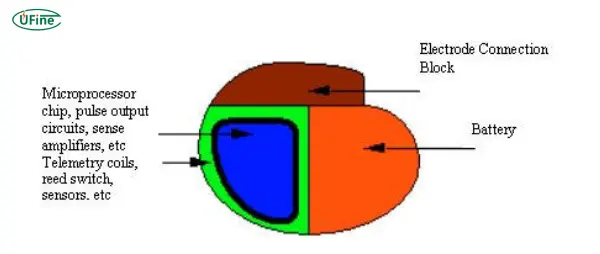
- Part 1. How does the battery affect pacemaker performance?
- Part 2. Pacemaker battery types
- Part 3. Pacemaker battery size
- Part 4. Pacemaker battery voltage
- Part 5. Pacemaker battery life: How long until replacement?
- Part 6. Signs your pacemaker battery is dying
- Part 7. Pacemaker battery price: What does replacement cost?
- Part 8. Can You recharge a pacemaker battery?
- Part 9. Pacemaker battery replacement: What to expect
- Part 10. Custom battery solutions by Ufine Battery
- Part 11. Conclusion
- Part 12. FAQs
For millions of people worldwide, a pacemaker is more than just a medical device—it’s a lifeline. Ensuring its uninterrupted function is critical, and at the heart of this reliability lies the pacemaker battery. But how much do you really know about this essential component?
In this detailed guide, we’ll explore every aspect of pacemaker batteries, from their types and lifespan to replacement procedures and costs. We’ll also discuss how to recognize a failing battery and introduce Ufine Battery, a leading manufacturer of custom lithium batteries that can meet specialized medical power needs.
By the end, you’ll have a deep understanding of how pacemaker batteries work, when to replace them, and even custom battery solutions for advanced medical applications.
Part 1. How does the battery affect pacemaker performance?

A pacemaker’s primary function is to regulate the heartbeat by sending precise electrical impulses. However, without a reliable power source, this life-saving device becomes useless. The pacemaker battery is the unsung hero that ensures consistent performance.
Why Battery Quality Matters
-
Stable Voltage Output: A weak battery may deliver inconsistent signals, leading to irregular heart rhythms.
-
Longevity: High-quality batteries last longer, reducing the need for frequent replacements.
-
Safety: Faulty batteries can fail abruptly, posing serious health risks.
Real-Life Impact: Imagine a patient relying on their pacemaker during physical exertion. If the battery is weak, the device might not respond quickly enough, causing dizziness or even fainting.
This is why choosing the right battery technology is crucial—not just for pacemakers but for all medical devices requiring long-lasting, dependable power.
Part 2. Pacemaker battery types
Not all pacemaker batteries are the same. Over the years, technology has evolved to improve efficiency and longevity.
Common Pacemaker Battery Types
-
Lithium-Iodine Batteries
-
Most widely used in modern pacemakers.
-
Long lifespan (typically 7-15 years).
-
Stable discharge rate, ensuring consistent performance.
-
-
Lithium-Carbon Monofluoride (Li-CFx)
-
Used in some implantable devices.
-
Higher energy density than lithium-iodine.
-
Often found in advanced cardiac devices.
-
-
Mercury-Zinc Batteries (Obsolete)
-
Used in older pacemakers.
-
Shorter lifespan and bulkier design.
-
Rarely used today due to environmental concerns.
-
Why Lithium Dominates the Market
-
Lightweight and compact—ideal for implantation.
-
No memory effect, meaning performance doesn’t degrade over time.
-
Reliable voltage output until near depletion.
Did You Know? Some manufacturers, like Ufine Battery, specialize in custom lithium batteries for medical applications, offering enhanced longevity and safety features.
Need a Custom Medical Battery?
Contact Ufine Battery today for tailored lithium battery solutions!
Part 3. Pacemaker battery size
Pacemakers must be small enough to implant comfortably under the skin, yet powerful enough to last years.
Typical Pacemaker Battery Dimensions
-
Diameter: ~20-40 mm (varies by model).
-
Thickness: ~3-6 mm.
-
Weight: ~20-30 grams.
Why Size Matters
-
A smaller battery means a more comfortable implant.
-
Thin, high-capacity batteries (like those from Ufine Battery) allow for sleeker, more efficient pacemaker designs.
Part 4. Pacemaker battery voltage
A pacemaker requires precise voltage control to function safely.
Standard Voltage Range
-
2.8V to 3.5V (most common).
-
Gradual voltage drop as the battery depletes.
What Happens When Voltage Drops?
-
The pacemaker may trigger a low-battery alert.
-
If ignored, the device could fail to pace properly, leading to bradycardia (dangerously slow heart rate).
Pro Tip: Some custom lithium batteries (like those from Ufine Battery) offer more stable voltage curves, extending usable life.
Part 5. Pacemaker battery life: How long until replacement?
One of the most common questions is: “How long does a pacemaker battery last?”
Factors Affecting Battery Life
| Factor | Impact on Lifespan |
|---|---|
| Pacing Demand | High pacing needs = faster drain |
| Battery Capacity | Larger batteries last longer |
| Device Efficiency | Newer models consume less power |
Average Lifespan Estimates
-
5-7 years (for patients with high pacing needs).
-
10-15 years (for those with minimal pacing).
Extending Battery Life
-
Regular check-ups to monitor battery status.
-
Using high-efficiency batteries (like custom solutions from Ufine Battery).
Part 6. Signs your pacemaker battery is dying
A failing battery won’t shut off suddenly—it gives warning signs:
Key Symptoms
✔ Frequent dizziness or fainting (due to missed pacing).
✔ Slower heart rate (pacemaker isn’t compensating enough).
✔ Device alerts (modern pacemakers beep or send remote alerts).
What to Do?
➔ Schedule an immediate check-up if you notice these signs.
➔ Never ignore warnings—delaying replacement can be life-threatening.
Part 7. Pacemaker battery price: What does replacement cost?
Replacement costs vary, but here’s a general breakdown:
Cost Factors
-
Battery type (lithium batteries cost more but last longer).
-
Hospital fees (surgery, anesthesia, etc.).
-
Geographical location (prices differ by country).
Estimated Costs
| Component | Price Range |
|---|---|
| Battery Only | $1,000 – $3,000 |
| Full Replacement Procedure | $5,000 – $15,000 |
Insurance Coverage?
-
Most plans cover part of the cost.
-
Check with your provider before scheduling surgery.
Part 8. Can You recharge a pacemaker battery?
Short answer: No.
-
Current pacemaker batteries are single-use.
-
Rechargeable pacemakers are in development but not yet mainstream.
Future Possibilities
-
Wireless charging prototypes are being tested.
-
Ufine Battery is researching longer-life lithium solutions for medical devices.
Part 9. Pacemaker battery replacement: What to expect
Step-by-Step Process
-
Pre-Surgery Check – ECG and battery status test.
-
Local Anesthesia – Numbing the implant area.
-
Incision & Replacement – Removing the old battery and installing a new one.
-
Closure & Recovery – Stitches or surgical glue; most patients go home the same day.
Recovery Time?
-
1-2 days for minor soreness.
-
Avoid heavy lifting for a few weeks.
Part 10. Custom battery solutions by Ufine Battery
While most pacemakers use standard lithium batteries, some medical applications require custom power solutions.
Why Choose Ufine Battery?
✔ Specializes in lithium polymer, LiFePO4, and ultra-thin batteries.
✔ Custom sizes, voltages, and capacities for unique medical needs.
✔ High-rate and high-temperature batteries for extreme conditions.
Part 11. Conclusion
Your pacemaker’s battery is its lifeline—and understanding how it works can save your life. From recognizing warning signs to knowing replacement costs, being informed ensures you stay protected.
For custom battery solutions, Ufine Battery offers high-quality lithium batteries tailored to medical needs. Whether you’re a patient, doctor, or medical device manufacturer, reliable power matters.
Stay proactive. Monitor your battery. And when in doubt—consult your cardiologist.
Need a Custom Battery Solution?
Contact Ufine Battery today for high-performance lithium batteries designed for medical precision!
This in-depth guide ensures you have all the knowledge needed about pacemaker batteries. Share it with others who might benefit—because when it comes to heart health, every detail counts.
Part 12. FAQs
Can a pacemaker battery be replaced without surgery?
A: No—the battery is sealed inside the pacemaker, requiring a minor surgical procedure.
How do doctors check battery life?
A: Through remote monitoring or in-clinic tests that measure remaining voltage.
What happens if the battery dies completely?
A: The pacemaker stops working, which can be life-threatening for pacemaker-dependent patients.
Are there alternatives to lithium batteries?
A: Currently, lithium is the standard, but research into solid-state and rechargeable batteries is ongoing.
Related Tags:
More Articles

Does a Higher mAh Battery Last Longer?
Does a higher mAh battery really last longer? Learn what mAh means, real battery life in hours, replacement safety (4000 vs 5000mAh), and real examples.
Exploring the Lithium Ion Battery Fire Temperature
Discover the lithium-ion battery fire temperature and learn how to stay safe. Get essential tips to prevent battery fires and protect your devices today.
The Ultimate Guide to 6s Lipo Batteries
A beginner-friendly guide to 6S LiPo batteries. Understand voltage, capacity, charging tips, safety rules, and real-world applications.
What is the NCMA battery? What is the difference between it and the NMC battery? Which one is better? This article will answer your questions.
What Is the Lithium Battery Short Circuit?
What is the lithium battery short circuit? To understand a lithium battery short circuit, we first need to understand how the battery works.




